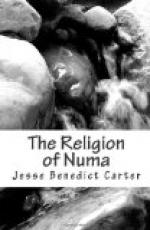It was the ceremonial of the cult however which most often offered the best means of identification, as we have seen above in the case of Bona Dea-Damia, where the exclusion of men from the rites was the main point of similarity. In a similar way the old Roman god of the harvest, Consus, was identified with the Greek ocean-god Poseidon because horse-races were a characteristic feature of the festivals of each; and the old Roman goddess of women and of childbirth was given as her Greek parallel the Greek goddess Leukothea, the helper of those in peril at sea, because in both cases slaves were forbidden to take part in the cult.
But the effect of the capture of Rome by these Greek gods and Greek ceremonials was not confined to the mere addition of new ideas, and the transformation of certain old Roman deities. This would have been comparatively harmless, but there was inevitably another result: the consequent neglect of all Roman deities for whom no Greek parallels were forthcoming, and the forgetting of all the original Roman ideas which were crowded into the background by the novel and more brilliant Greek ideas. Even the festivals of the old Roman year were treated in the same cavalier manner. The interest of the people continued only with those ceremonies which frightened them or pleased them. There were certain festivals, for example the Lupercalia, the old ceremony of purification on February 15, for which a reverence was still felt; and others like the Parilia, the birthday of Rome, on April 21, or the Anna Perenna festival on March 15, which involved open-air celebrations and picnics. These and others like them were always kept up, while many others were totally neglected. Naturally for the present the forms were continued by the state; the festivals were celebrated at least by the priests; and every temple received sacrifice on its birthday. The wheels of the state religion were still running, but the power behind them had stopped, and it was only momentum which kept them in motion.
It is only when we realise these things that we can understand how it was possible that the most learned scholars at the close of the republic were so desperately ignorant concerning old Roman religion. In regard to many of the old Roman gods they know absolutely nothing, and try to disguise their ignorance behind a show of learning based on etymological sleight-of-hand; in regard to the rest their information is so tangled with Greek ideas that it is often almost impossible to unravel the mass and separate the old from the new. This unravelling has been the tedious occupation of the last half century in the study of Roman religion; and so patiently and successfully has it been accomplished that, although we would give almost anything for a few books of Varro’s Divine Antiquities, it is tolerably certain that the possession of these books would not change in the least the fundamental concepts underlying the modern reconstruction of ancient




